Seagate Technology Bundle
How Does Seagate Technology Thrive in the Data Age?
Seagate Technology, a titan in data storage, is indispensable in today's digital world. From enterprise servers to personal devices, its Seagate Technology SWOT Analysis reveals the company's strategic positioning. With a reported revenue of $1.66 billion in Q2 FY2024, understanding Seagate's operations is crucial for anyone navigating the tech landscape.
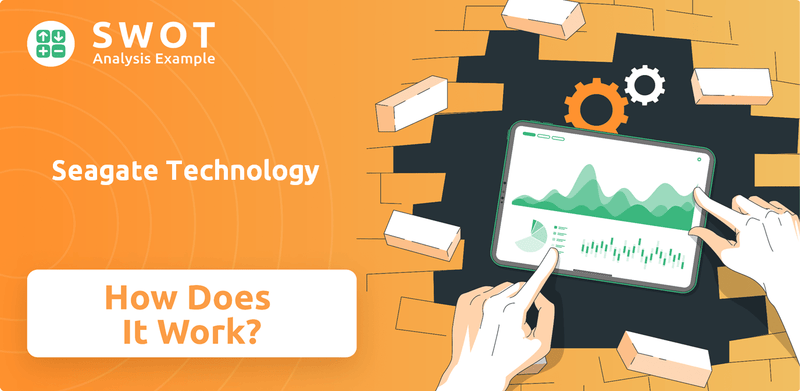
This deep dive into the Seagate company will explore its core operations, encompassing its manufacturing process and the technologies behind its Seagate hard drives. We'll examine its diverse revenue streams, market share, and the competitive landscape, including Seagate's competitors. Moreover, we'll analyze Seagate hard drive performance, its SSD offerings, and its strategic responses to the ever-evolving demands of data storage, providing insights into its financial performance and future outlook, including details about Seagate data recovery services and the Seagate hard drive warranty.
What Are the Key Operations Driving Seagate Technology’s Success?
Seagate Technology creates value by providing comprehensive data storage solutions, primarily focusing on hard disk drives (HDDs) and solid-state drives (SSDs). These products serve a wide range of customers, including hyperscale data centers, cloud service providers, and individual consumers. The company's operations are vertically integrated, encompassing research and development, design, manufacturing, and global distribution. This integrated approach allows for rigorous quality control and innovation in storage technology.
The manufacturing process at Seagate company involves specialized facilities for component production, assembly, and testing. Their supply chain is a complex global network, sourcing materials from various suppliers worldwide. Advanced automation and sophisticated logistics ensure efficient production and timely delivery. Technology development is a continuous process, with significant investments in areas like HAMR (Heat-Assisted Magnetic Recording) technology for HDDs and advancements in NAND flash technology for SSDs.
Sales channels include direct sales to large enterprise customers and OEMs, as well as a network of distributors and retailers. Customer service and technical support are provided globally. Seagate hard drives are known for their high-capacity storage, reliable performance, and cost-effective solutions, differentiating the company in a competitive market. This operational excellence and technological leadership are key to its success.
Seagate's core operations involve the design, manufacture, and sale of data storage solutions. This includes HDDs and SSDs, catering to diverse markets. The company's vertically integrated model allows for control over the entire process, from research to distribution.
The value proposition centers on providing high-capacity, reliable, and cost-effective storage solutions. Seagate offers a range of products to meet various customer needs, from enterprise to consumer markets. Their focus on innovation and quality ensures customer satisfaction.
Seagate's manufacturing process is highly specialized, with facilities dedicated to component production, assembly, and rigorous testing. Advanced automation and a global supply chain are crucial for efficient production. The company focuses on continuous improvement and technological advancements.
Seagate utilizes a multi-channel sales strategy, including direct sales, distributors, and retailers. This approach ensures broad market reach. Customer service and technical support are provided globally to support product sales and customer satisfaction.
Seagate's expertise in magnetic recording technology and its ability to scale production are key differentiators. The company invests heavily in R&D to stay ahead of the competition. They focus on delivering high-capacity, reliable, and cost-effective storage solutions.
- Advanced Technology: Investments in HAMR and NAND flash technologies.
- Global Presence: Extensive supply chain and distribution network.
- Customer Focus: Comprehensive customer service and technical support.
- Market Leadership: Strong position in both HDD and SSD markets.
Seagate's financial performance reflects its market position. For example, in fiscal year 2024, the company reported revenue of approximately $7.3 billion. The company's ability to adapt to changing market demands and technological advancements plays a crucial role in its continued success. For a deeper understanding of the competitive landscape, consider exploring the Competitors Landscape of Seagate Technology.
Seagate Technology SWOT Analysis
- Complete SWOT Breakdown
- Fully Customizable
- Editable in Excel & Word
- Professional Formatting
- Investor-Ready Format
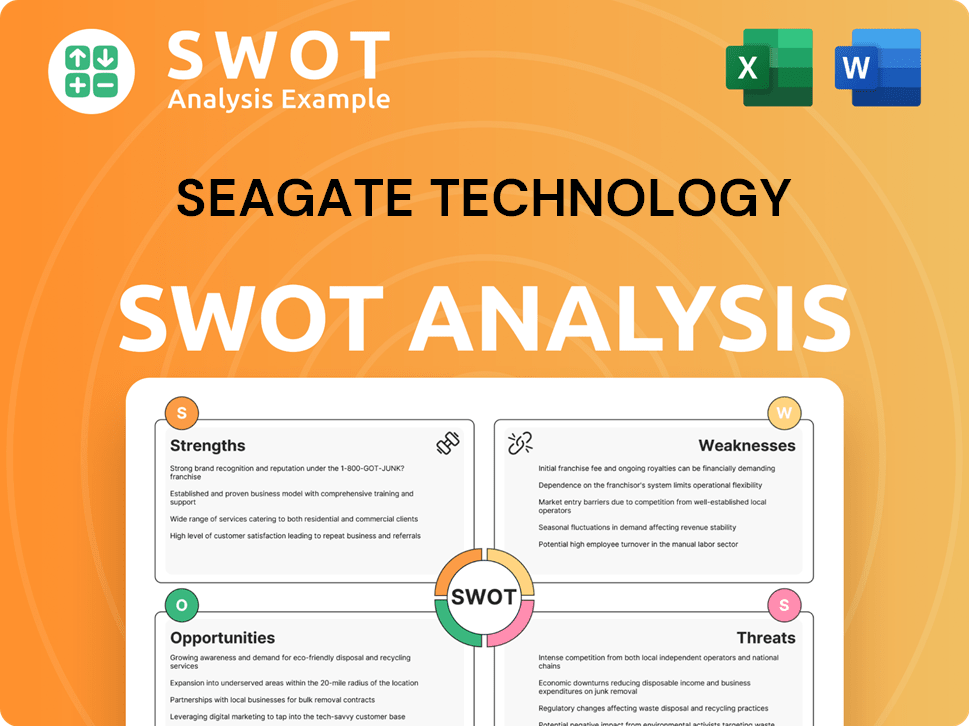
How Does Seagate Technology Make Money?
Seagate Technology's revenue streams primarily revolve around the sale of data storage products. This includes both hard disk drives (HDDs) and solid-state drives (SSDs), alongside other storage solutions. The company's financial performance is significantly influenced by the demand for these products across various market segments.
The company's monetization strategy is largely volume-based, selling a high quantity of drives to a diverse customer base. This approach is crucial for maximizing revenue and maintaining a competitive edge in the data storage market. For the second quarter of fiscal year 2024, Seagate reported revenue of $1.66 billion.
Seagate's business model focuses on the production and distribution of data storage solutions, with a strong emphasis on HDDs, especially for enterprise and nearline applications. The company's product portfolio is strategically designed to meet the evolving needs of its customers, from cloud providers to individual consumers.
HDDs historically constitute a substantial portion of Seagate's revenue, particularly in the enterprise and nearline segments. These drives are essential for mass capacity storage in data centers.
Sales of SSDs and other storage solutions are also significant. The growth of SSDs reflects the increasing demand for faster storage in various applications.
Seagate works directly with large cloud providers and data center operators in the enterprise segment. Long-term supply agreements are common in this area.
Products are integrated into computers, servers, and other electronic devices for the OEM market. This segment is crucial for driving volume sales.
Products are sold through distribution partners and online channels in the retail and consumer segments. This broadens the customer base.
Seagate generates revenue from licensing its technology and providing related services. These typically represent a smaller portion of total revenue.
Seagate continuously adjusts its product mix and pricing strategies to optimize profitability. The company's focus on high-capacity enterprise drives and the growing adoption of SSDs are key trends. For a deeper dive into the company's strategic direction, consider reading about the Growth Strategy of Seagate Technology.
- Market Share: Seagate competes with other major players in the data storage market.
- Product Innovation: Continuous innovation in HDD and SSD technology is vital.
- Customer Relationships: Building and maintaining strong relationships with key customers is essential.
- Cost Management: Efficient manufacturing processes are critical for profitability.
Seagate Technology PESTLE Analysis
- Covers All 6 PESTLE Categories
- No Research Needed – Save Hours of Work
- Built by Experts, Trusted by Consultants
- Instant Download, Ready to Use
- 100% Editable, Fully Customizable
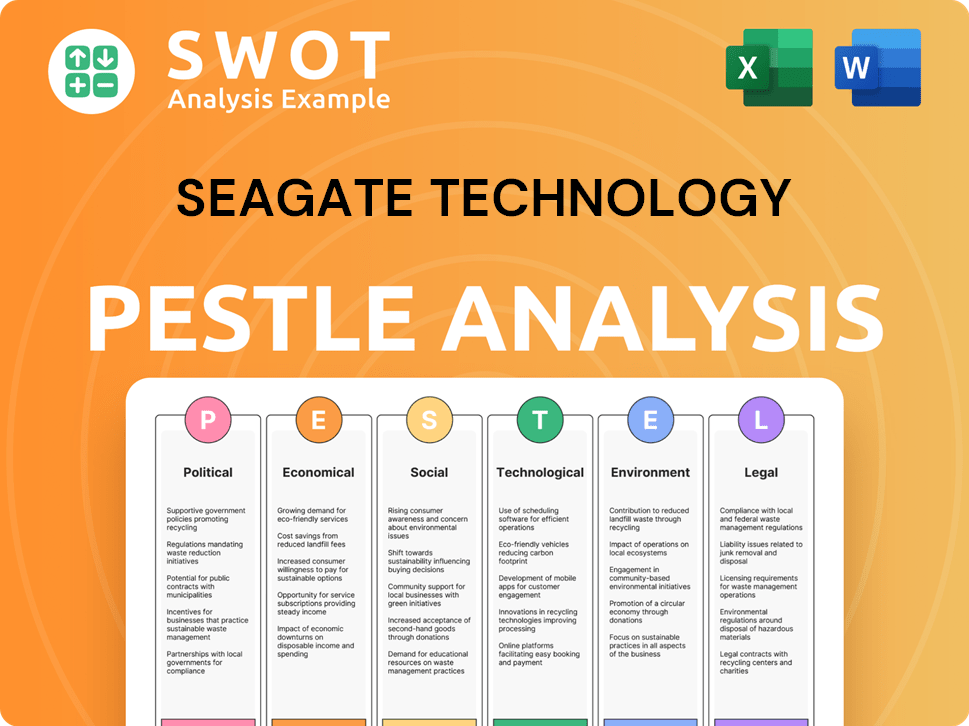
Which Strategic Decisions Have Shaped Seagate Technology’s Business Model?
Seagate Technology has a rich history, marked by significant milestones in the data storage industry. The company's strategic moves have consistently focused on innovation, particularly in hard disk drive (HDD) technology. These efforts have been crucial in navigating market challenges and maintaining a competitive edge in the ever-evolving landscape of data storage solutions.
A key strategic focus for Seagate has been continuous investment in research and development. This commitment has led to advancements like Heat-Assisted Magnetic Recording (HAMR), designed to increase storage density and improve performance in HDDs. This innovation is vital to meet the growing demand for data storage across various sectors.
Seagate's competitive advantages stem from its technological expertise, large-scale manufacturing capabilities, and strong brand reputation. The company's ability to adapt to market changes, such as the shift towards enterprise and cloud-focused storage, has been critical to its sustained success. Furthermore, strategic partnerships and a focus on high-capacity drives demonstrate its commitment to meeting evolving market needs, ensuring its business model remains relevant in a dynamic technological environment.
Seagate's journey includes significant milestones, such as pioneering advancements in HDD technology. The company has consistently adapted to market changes, including the rise of cloud computing and the increasing demand for data storage. These adaptations have been crucial for maintaining a strong market position.
Strategic moves include heavy investment in R&D, particularly in HAMR technology. The company has also focused on expanding its product portfolio to include enterprise-class storage solutions and solid-state drives (SSDs). These moves aim to cater to diverse market segments and address evolving customer needs.
Seagate's competitive edge lies in its technological expertise in magnetic recording and data storage. Economies of scale, derived from its large-scale manufacturing operations, also contribute to cost-effective production. Brand strength and a reputation for reliability enhance customer loyalty, especially among enterprise clients. The company's extensive patent portfolio protects its intellectual property.
Seagate has adapted to the rise of artificial intelligence and machine learning by focusing on high-capacity storage solutions. Strategic partnerships with cloud service providers and a focus on high-capacity nearline drives demonstrate its commitment to addressing these evolving market needs. The company's ability to innovate and adapt is crucial for its long-term success.
Seagate's advancements in HDD technology, such as HAMR, are crucial for maintaining its market position. The company faces competition from other major players in the data storage sector. As of 2024, Seagate's market share in the HDD market remains significant, with a focus on both enterprise and consumer segments.
- Seagate continues to invest in R&D to improve HDD capacity and performance.
- The company is expanding its SSD offerings to meet growing demand.
- Strategic partnerships with cloud providers are key to its growth strategy.
- Seagate's focus on data recovery services and warranty offerings enhances customer value.
For a deeper dive into how Seagate is navigating the competitive landscape and driving growth, explore the Growth Strategy of Seagate Technology. The company's focus on innovation and strategic adaptation is key to its sustained success in the data storage market. In 2024, Seagate continues to focus on high-capacity HDDs and SSDs to meet the increasing demands of data storage, with a strategic emphasis on the enterprise and cloud markets. The company's revenue for fiscal year 2024 was approximately $7.1 billion, reflecting its ongoing efforts to adapt to market trends.
Seagate Technology Business Model Canvas
- Complete 9-Block Business Model Canvas
- Effortlessly Communicate Your Business Strategy
- Investor-Ready BMC Format
- 100% Editable and Customizable
- Clear and Structured Layout
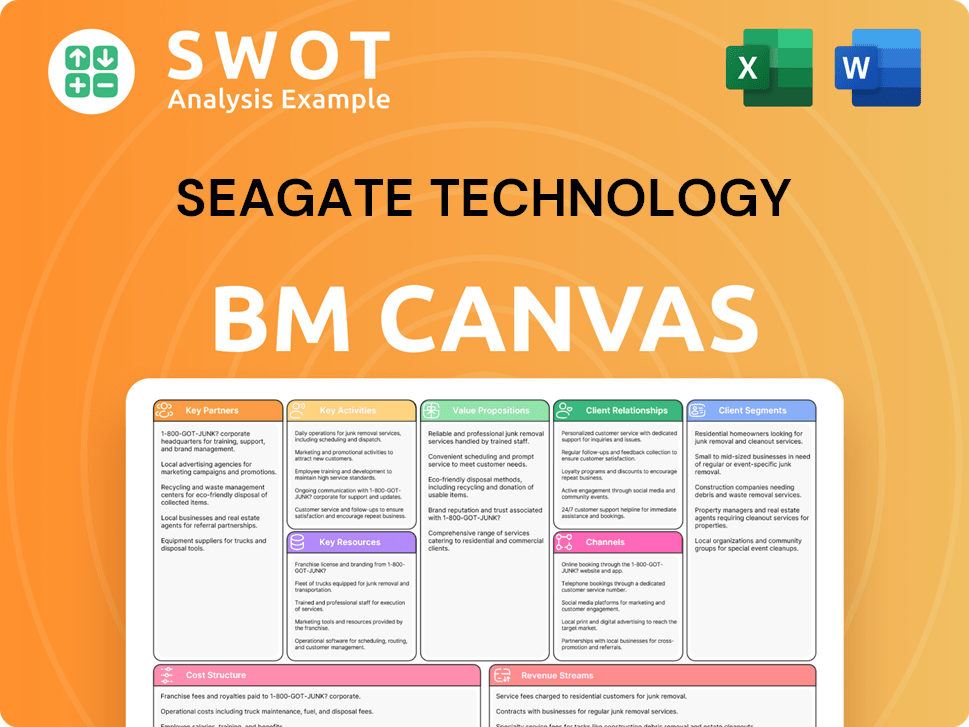
How Is Seagate Technology Positioning Itself for Continued Success?
Seagate Technology holds a significant position in the global data storage market, especially in the enterprise and nearline HDD segments. It competes primarily with Western Digital and Toshiba. The company's strong market share is driven by the consistent demand for mass capacity storage in data centers and cloud environments. Its established customer relationships and global presence further solidify its market standing.
However, Seagate faces several risks, including technological disruptions from alternative storage methods, intense price competition, and the cyclical nature of demand in certain market segments. Regulatory changes, such as those related to data privacy, could also impact data storage requirements and demand. Furthermore, geopolitical factors and supply chain vulnerabilities pose operational challenges.
Seagate is a major player in the data storage industry, particularly in HDDs. It competes with Western Digital and Toshiba, maintaining a substantial market share. The company's success is tied to its ability to meet the increasing need for storage in cloud environments and data centers.
Key risks include technological shifts, price competition, and demand fluctuations. Regulatory changes and geopolitical factors also pose challenges. The company must navigate these risks to maintain its market position and profitability.
The future outlook for Seagate involves leveraging its technological leadership to capitalize on data growth. This includes advancements in HAMR technology for higher areal densities in HDDs and expanding its SSD offerings. Seagate aims to sustain profitability through innovation and strategic alignment with market needs.
Seagate is focused on HAMR technology to increase HDD storage capacity. It is also expanding its SSD portfolio and storage systems. Leadership is committed to sustainable data storage and high-value segments. For more insights, you can read a Brief History of Seagate Technology.
Seagate's strategy revolves around innovation in storage technology and adapting to market changes. The company invests in technologies like HAMR to increase HDD capacity. It also focuses on expanding its SSD offerings.
- HAMR Technology: High-capacity HDDs for data centers.
- SSD Expansion: Growing its enterprise SSD portfolio.
- Sustainable Solutions: Commitment to eco-friendly storage.
- Market Alignment: Tailoring products to meet evolving data needs.
Seagate Technology Porter's Five Forces Analysis
- Covers All 5 Competitive Forces in Detail
- Structured for Consultants, Students, and Founders
- 100% Editable in Microsoft Word & Excel
- Instant Digital Download – Use Immediately
- Compatible with Mac & PC – Fully Unlocked
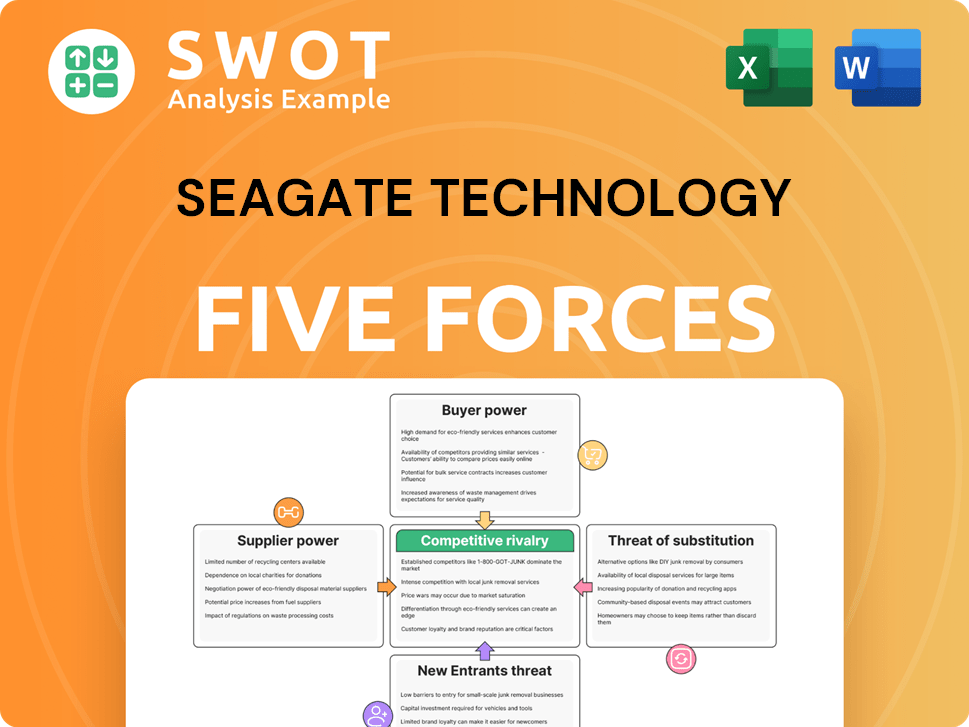
Related Blogs
- What are Mission Vision & Core Values of Seagate Technology Company?
- What is Competitive Landscape of Seagate Technology Company?
- What is Growth Strategy and Future Prospects of Seagate Technology Company?
- What is Sales and Marketing Strategy of Seagate Technology Company?
- What is Brief History of Seagate Technology Company?
- Who Owns Seagate Technology Company?
- What is Customer Demographics and Target Market of Seagate Technology Company?
Disclaimer
All information, articles, and product details provided on this website are for general informational and educational purposes only. We do not claim any ownership over, nor do we intend to infringe upon, any trademarks, copyrights, logos, brand names, or other intellectual property mentioned or depicted on this site. Such intellectual property remains the property of its respective owners, and any references here are made solely for identification or informational purposes, without implying any affiliation, endorsement, or partnership.
We make no representations or warranties, express or implied, regarding the accuracy, completeness, or suitability of any content or products presented. Nothing on this website should be construed as legal, tax, investment, financial, medical, or other professional advice. In addition, no part of this site—including articles or product references—constitutes a solicitation, recommendation, endorsement, advertisement, or offer to buy or sell any securities, franchises, or other financial instruments, particularly in jurisdictions where such activity would be unlawful.
All content is of a general nature and may not address the specific circumstances of any individual or entity. It is not a substitute for professional advice or services. Any actions you take based on the information provided here are strictly at your own risk. You accept full responsibility for any decisions or outcomes arising from your use of this website and agree to release us from any liability in connection with your use of, or reliance upon, the content or products found herein.